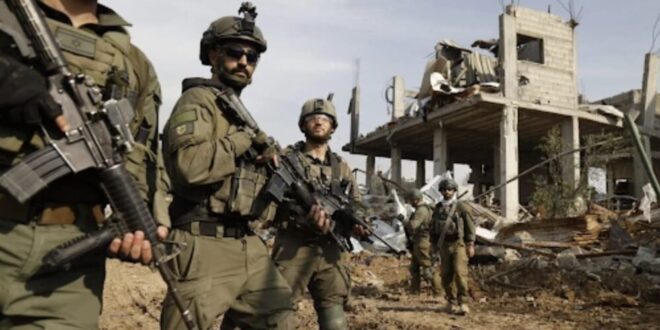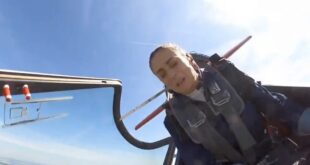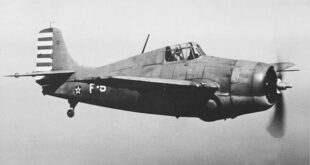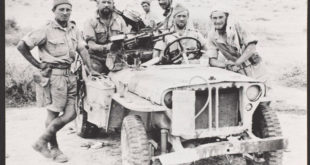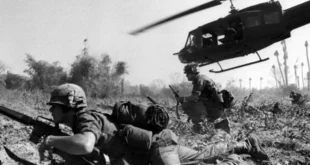A riveting story of the bold and secret operation, told by a former IDF commando.
by Elon Perry
On 12 May, Israel received intelligence about the location of four hostages in the Nuseirat refugee camp area in the Gaza Strip. From that day on, every branch of Israeli intelligence was focused on the area 24 hours a day, 7 days a week, to locate the exact location. A team of undercover ‘Mista’arvim’ (units that assimilate into local populations to gather intelligence) were sent there, mainly in the local market of Nuseirat.
Their role was not only to gather intelligence from locals but also to check information from the interrogations of captured terrorists. In addition, information was gathered by aerial observation and other sophisticated technological means.
After 19 days of intensive cooperative intelligence gathering work, the combined units managed to compile solid and accurate information about the location of the Israeli hostages. It was discovered that the hostages were being held in two separate buildings in the same area. Noa Argamani was held in the first floor of one and three other hostages were in another building, 800 metres away, on the third floor.
At the beginning of June, this information was brought to the War Cabinet, and the Chief of Staff of the IDF and head of the Shin Bet were asked to present a rescue plan. The intelligence was kept top secret. Even the other forces in Gaza, including senior commanders, were not informed about it. As the War Cabinet discussed options, the preparations and training for the operation began.
SEE Elon Perry’s new book, Children in War: A First-Hand Account of the Israeli-Palestinian Conflict
In order to finally verify the information and to prepare the ground for the operation, another team of undercover soldiers (including several women dressed in hijabs and long black dresses) was sent into the Nuseirat refugee camp. Pretending to be two Gazan families looking for a large house in Nuseirat, they arrived in two cheap-looking old cars loaded with domestic items characteristic of those families displaced in the Strip, such as mattresses and clothing identical to those of the locals.
When the residents of the Nuseirat camp asked the undercovers where they came from and what they were looking to do in Nuseirat, they replied that they had fled from Rafah due to “deadly shelling from the Israeli army”, and decided to rent a house in the area. Then they pointed to the building where Noa Argamani was being held. They showed one of the locals a large amount of cash and offered to pay three times the going rate for rent. The local agreed to help and within three hours found a large house on the very street where Argamani was held. This was only 800 metres away from where the other three hostages were held.
A few days later, after settling into the house and getting to know the area, including shopping at the local market, and realising that they did not arouse suspicion, the undercovers began their mission: verifying the location where the hostages were held.
They split into two teams. One team consisted of two commandos, a man dressed as a typical Gazan local and a woman dressed in a long black dress and hijab. They began marching down the street towards the ‘Al-Auda’ medical centre where, in a nearby residential building 200 metres from the hospital, Noa Argamani was held.
The undercovers walked with complete confidence as if they were walking down a street in Tel Aviv. To add to their authenticity, they stopped from time to time at stalls along the sides of the street, showing interest in the products while complaining about the difficult situation in Gaza. This was done in fluent Arabic with a perfect Gazan accent. Behind them walked four more undercover men, armed to give backup in case a ‘Fauda-like’ situation occurred (Fauda in Arabic means unexpected chaos).
The second team consisted of four female soldiers dressed as typical Arab women (one feigning being pregnant) carrying plastic bags full of food products and vegetables. They walked in two pairs (a young Muslim woman is not allowed to walk around alone) towards a nearby residential building, where, on the third floor, the three male hostages were held. Behind them walked four more undercover men armed to give them backup.
Meanwhile five other members of the undercover team stayed at the house to guard it and make sure the teams had not been exposed and that no nasty surprises would await them.
The Location is Confirmed
Three hours later, at the prearranged time, the two teams came back to the rented house and began to process the information they had obtained. Now it was confirmed: the four hostages were being held in two homes of Gazan families. The force commander confirmed to Israel that the two locations were correct.
The cabinet decided to act. Twenty-eight fighters from the ‘Yamam’, a commando unit that specialises in fighting terrorists and rescuing hostages, began training on two specially built models that replicated the two buildings where the hostages were held. After three days of training, the commander of the force informed the IDF Chief of Staff, Herzi Halevi, who then informed the Minister of Defence, Yoav Gallant, that they were ready to carry out the operation.
After Prime Minister Netanyahu had been informed and given permission to launch the operation, it was able to proceed.
On Thursday night, 5 June, the undercovers were ordered to leave the area of Nuseirat refugee camp without arousing suspicion, although four remained to keep an eye on the buildings to make sure that the hostages were not transferred to another location.
Only at this time were senior Israeli commanders and other cabinet members informed about the operation.
On Friday morning, 6 June, the 28 commandos of the ‘Yamam’ unit began making their way in two teams towards the two buildings in Nuseirat refugee camp. To maintain the element of surprise as much as possible, the unit’s fighters travelled hiding in two trucks.
Just before 11 am the commandos arrived with precise timing at the two targets and awaited the order to attack. Observations and technological surveillance measures from IDF aircraft reported that the area was ‘clean’, with no suspicious movements near the two buildings. The information and live coverage of the alleys and the 800-metre-long street that separated the two target buildings were transmitted directly to the screens in two command and control rooms in Israel from which the operation was being overseen.
At 11.00 am exactly the commandos received the order to go ahead and stormed both buildings simultaneously in full coordination, to prevent the terrorists from endangering the hostages and the entire operation.
The Israeli soldiers eliminated the terrorists guarding Noa Argamani, and within six minutes had rescued her unharmed from the apartment. They then took her to a waiting helicopter that immediately flew her back to Israel.
The Task Becomes Complicated
But while the rescue of Argamani went smoothly, the task of rescuing the other three hostages on the third floor of the second building became complicated.
They were held in the home of Dr Ahmed al-Jamal, a medical doctor, who was a Hamas activist. His son, Abdullah, a journalist who had written for Al-Jazeera, was also staying in the apartment.
Some of the commandos used a ladder to enter directly into the room where the three hostages were held. This coincided with the entry of the rest of the force who came up the stairs from the main entrance of the building.
But Commander Arnon Zamora’s team, which broke into the apartment at the head of the force, encountered massive fire from around thirty Hamas terrorists in the apartment. They fired with machine guns, threw grenades, and some even fired rocket-propelled grenade missiles at the surprised Israelis. This is how Arnon Zamora was killed.
The fact of the presence of 30 terrorists in the apartment had not been known to the undercover teams who had reported the information about the hostages’ location back to Israel. It is assumed that the terrorists arrived at the apartment only that morning or the night before, to strengthen the guarding of the three hostages.
Nevertheless, the experienced Israeli commando fighters were not deterred by the deadly surprise and continued to fight the terrorists with determination at close range, joined by the other fighters who were waiting outside the apartment. The three hostages had to hide in the bathroom of the apartment, protected by several Israeli fighters, during the battle. There was no way to leave the apartment due to the massive unexpected gunfire, as it might endanger the hostages.
After a long face-to-face battle, the Israelis managed to eliminate all the terrorists in the apartment. But during the shooting from dozens of guns inside a crowded two-room apartment, Arnon Zamora was hit and lay on the floor bleeding, while three medics and a doctor leant over him, under heavy fire, trying to save his life.
Meanwhile, dozens of terrorists emerged from the tunnels around the building and began to fire at the Israeli fighters with machine guns and RPG missiles. The Israelis started making their way out of the building (several of them carrying Arnon Zamora on a stretcher), running through smoke-filled alleys and the nearby market which was crowded with thousands of Gazans who would not have hesitated to lynch them. The Israeli forces tried, under constant fire, to get to the rescue vehicle that was waiting for them, but it was hit by two RPG missiles.
Activating ‘Plan B’
The commander of the operation in Israel then activated ‘Plan B’, the rescue plan that had been prepared in advance: a daring operation under massive, very close fire from the enemy, covered by Israeli fire from ground, sea and air.
With the help of tanks, hundreds of soldiers (from the Golani and Givati infantry brigades and paratroopers) charged on foot into the refugee camp, fighting face-to-face battles with Hamas terrorists while navy ships covered them from the west and air force helicopters from the east. Fire from the air hit the terrorists just ten metres from the Israeli soldiers.
The reinforcement forces and the air force managed to isolate the battle scene, providing a safe escape route for the main force escorting the three hostages.
At the end of an exhausting and continuous battle the Israeli fighters eliminated all the armed threats in the battle arena.
Hamas claims that during the rescue operation in the crowded streets of the refugee camp, 274 Palestinians were killed. However, the IDF says that 104 Palestinians were killed or wounded – all of whom were Hamas terrorists or armed civilians who collaborated with the terrorist organisation.
After the battle, the three abductees (who had kept their cool throughout) were led by the fighters to one of the Israeli helicopters waiting for them and flew them to Israel.
Meanwhile, the air force planes bombed the building, which collapsed within seconds.
The special forces soldiers then boarded the other two helicopters that took off back to Israel.
Attempts to revive Arnon Zamora continued on the short flight, but he was pronounced dead on arrival in hospital.
Elon Perry is a journalist and former commando in the Golani Brigade of the IDF. See his new book, Children in War: A First-Hand Account of the Israeli-Palestinian Conflict.
 Soldier of Fortune Magazine The Journal of Professional Adventurers
Soldier of Fortune Magazine The Journal of Professional Adventurers


